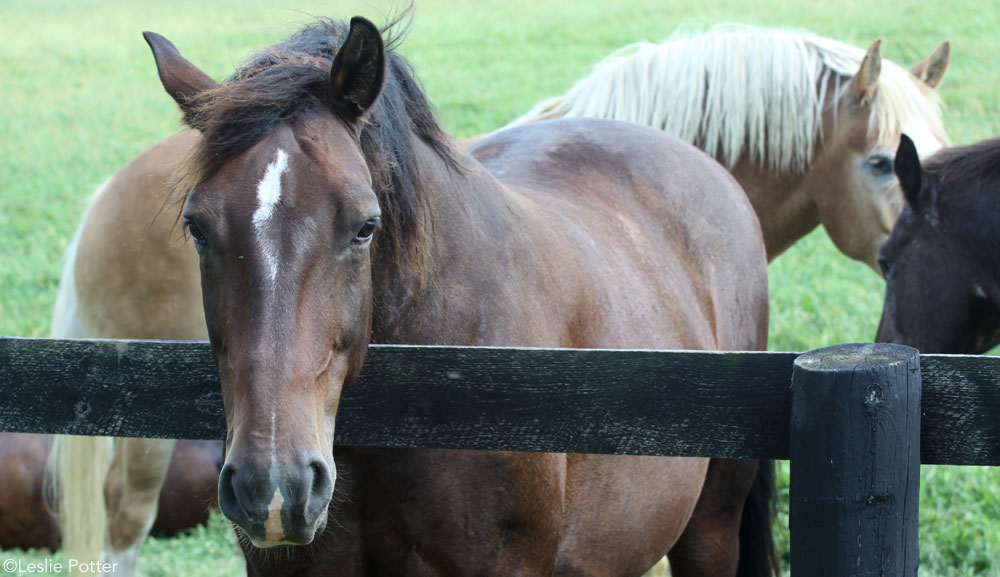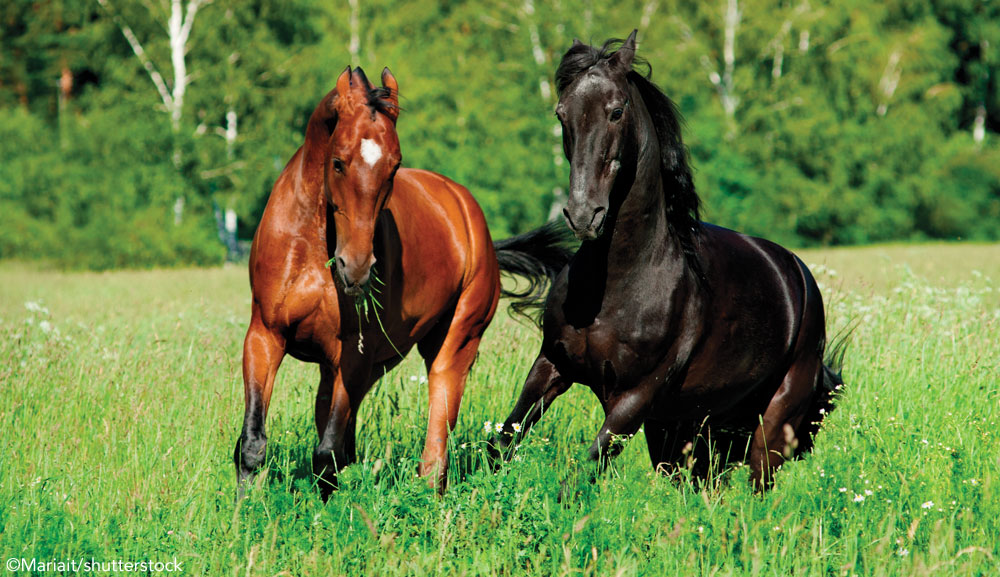Horses are curious creatures, known for sticking their noses (and legs) where they don’t belong. At first glance, you may think that everything is in order on your property. But once you look closely, it might surprise you how many hazards exist.

Stabling Hazards
Begin by taking a walk through your barn, carefully checking all edges and corners. Look for chewed or broken pieces of wood, splinters, nails, or bolts protruding from posts or boards. Secure boards in stalls and install edging that prevents chewing and loosening of structural components of the barn.
Stall doors should fit snugly and securely against doorjambs without gaps that could catch a leg. Align stall mats together flat on the floor to prevent foot entrapment. Fill in holes or low spots of dirt floors so a horse won’t get cast.
Check feeders for sharp edges. Even a seemingly innocuous bucket hook or salt block container can rip tender horse skin. Construct walls with strong, non-splintering wood and pad them against kicks. Stable compatible horses next to each other to limit emotional friction or fighting across walls or fences.
Crossties are potentially dangerous if a horse rears or spooks yet finds his head constrained. A horse could flip and injure his head, neck or withers.
Avoid using crossties on a flighty horse, or at the least use a loop of baling twine between the wall bolt and the ends of crossties. The twine will snap if triggered by a horse’s full weight. It’s also a good idea to keep a knife handy in the barn or clipped to your belt for immediate access in case you need to free a trapped horse.
Electrical lines and cords should be well out of a horse’s reach, attached securely and encased in conduit. Stow electrical cords away from foot traffic. Cover cords of electric tank heaters in PVC pipe to protect against chewing and possible electrocution.
Stall aisles harbor hazards from anything that isn’t flat and flush with a wall: saddle racks, wheelbarrows, pitchforks and rakes, chairs, et cetera. Move these to a safe location.
Around the Property
Many potential traumatic injuries can be prevented by simply cleaning up the property. Don’t park implements or machinery with sharp, projecting metal points and edges where it can snag a horse. Secure equipment in areas where horses never go, or fence it off separate from the horses.
Horse-safe fencing materials help reduce the risk of injury, although there’s no completely risk-free way to confine horses. It’s not surprising that barbed wire is a perilous fence material, but smooth or high-tensile wire, cabled wire, and even board fencing can cause bad injuries. If using prefab pipe panels, these should be made from round metal stock, not flat material with sharp edges. Ensure that there is sufficient spacing between rungs that won’t entrap a foot. Fill the gaps between panels and gates with PVC sections cut lengthwise and firmly attached; this minimizes the chance of a horse’s head or neck getting lodged in a tight space.
Examine stall door and gate latches. Ends with a 90-degree angle can gouge a horse moving quickly past the latch.
T-posts or pipe posts are also a hazard unless capped. Unprotected tops can easily lacerate or impale a horse. Wide, rounded plastic caps blunt the blow and are less likely to penetrate skin. Sharp, triangular wings of fallen T-posts, or those that are only half-buried in the ground, should also be removed or fully buried.
You can also create a safety barrier using electric wire or tape around the inside perimeter of a fence. Ensure that electric fences are plugged in or are solar charged. Wire, tape or cord fences that aren’t charged pose tangle hazards.
In the long haul, it’s less expensive to replace fencing with safe materials than to rack up vet bills, not to not to mention the potential harm to your horse.
Escape Artists
Horses often want to be where the grass is supposedly greener. Leaning on fence lines weakens posts and boards. From boredom, they’ll spend hours working a latch with their mouths; if it opens, the horse can now access areas where he shouldn’t be. Although a horse may escape through tenacity, it’s invariably people who accidentally leave latches unsecured.
As added security, use a clip or snap as a backup lock on doors and gates. An escaped horse often aims for the place on which he focuses much of his daily attention: the feed room.
Since overconsumption of grain or rich hay can cause gastrointestinal upset and/or laminitis, think Fort Knox: block off the feed room and store feed behind secure latches.
Some horses attempt to leave their paddock or pasture by jumping over a fence. Enclosures should be at least 4 ½ to 5 feet tall for stalls and 6 feet high for pastures. Another consequence of escape is that a horse might end up in a group of horses that take exception to the intruder’s presence, and a kicking match might ensue.

Pastured and Unattended
For large portions of the day, horses are left to their own devices without human supervision, and are capable of finding or making trouble. Consider ways to not add to their propensity for injury.
Halters left on horses pose a potentially fatal hazard, especially for foals. Halters trap legs when scratching or get snagged on stationary objects as a horse passes by, especially if moving at a run. This can have catastrophic consequences. It’s best to avoid leaving halters on pastured horses, but if you must, use a breakaway halter designed with a leather strap or one made entirely of leather, which will break in an emergency. Leather neck collars, like those used on broodmares, are fairly safe to leave on if your horse is hard to catch.
Continually re-evaluate the dynamics and social situations of your herd. It often works best to stable geldings only with geldings, and mares with mares. Individuals have their own personalities; dominance hierarchies develop and change as the group evolves.
Have a few different turnout pens and group horses that seem to get along well, but be ready to modify the arrangement. At feeding times, spread hay piles far apart to allow horses to move away from dominant or aggressive individuals.
When introducing a new horse to a herd, pick one of the less aggressive horses and let the two buddy up with a safe fence in between. Then move them together into a small pasture or large pen. Once they have established a safe relationship, turn them out as a pair with the others, but stick around to break up altercations.
Turnout Hazards
A pasture may have hidden hazards such as rocks, low spots, ditches, or holes that could cause a horse to trip. Fence off any that present major safety concerns.
One common quandary is whether to risk turnout when bad weather creates treacherous footing, such as mud, ice or snow. You’ll have to weigh the risk of potential injury on slippery ground with the benefits of turnout.
It’s probably worth the extra work mucking a stall or paddock while waiting for better weather and footing. To minimize slick surfaces in paddocks and runs, provide good drainage by taking advantage of gentle slopes for runoff and using gravel in more difficult areas.
The Bottom Line
Some of the best advice is to try to think like a horse. One of the best ways to monitor your property for potential problems is to look at your place as if you were going to buy it.
In addition, ask your veterinarian to examine the farm and stabling for potential hazards. Veterinarians have the advantage of knowing firsthand what commonly happens when horses encounter hazards on the farm.
This article originally appeared in the September 2016 issue of Horse Illustrated magazine. Click here to subscribe!





